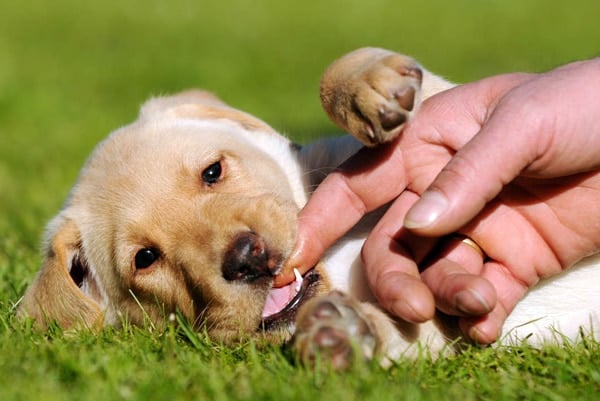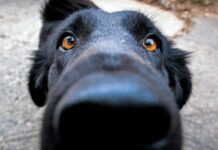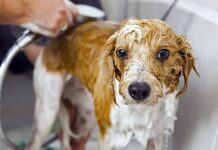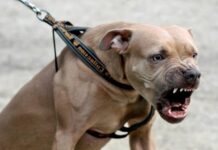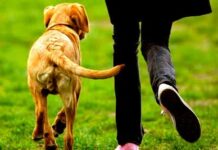Teething is simply the phase in which a puppy gets his teeth, or changes his baby teeth for permanent ones. All dogs go through this process because they are born without any teeth, which is understandable because they could really hurt their mother when nursing.
If you have a dog or had one in the past, you no doubt remember those moments when they literally want to chew everything. It’s a process that can be quite painful to get in the middle of; you should be especially careful with the first teeth, which are usually sharp as needles. Let’s look at the canine teething period step by step.

What is the teething period in puppies?
Puppies are born without teeth, although this doesn’t stop them from trying to chew everything that crosses their path. That’s why it’s so important to always have a chew toy handy and show him from a very young age that it’s not okay to bite his owner or other people. He should take it out on his toys, not people, furniture, shoes, etc.
This is easier said than done, of course, since they usually destroy sneakers, socks, and low furniture.
From four weeks old is when their first baby teeth start coming out. These are just like human baby teeth – temporary teeth that will be replaced by permanent ones, although that doesn’t mean they aren’t important. Some dogs start to develop a bit earlier and others a bit later, but on average four weeks is a good reference point.
When all of their baby teeth come out, they will have a total of 28 or 32 teeth, depending on the dog. In this stage, they won’t develop their premolars or molars. Their baby teeth are very sharp and thin and can hurt a lot if your dog gives you a love nip while playing.

Teething in young dogs, the permanent change
Now we have our puppy with all of his baby teeth, enjoying life and eating solid foods (dog food or a natural diet like the BARF diet). Some people think that the baby teeth grow and form the permanent teeth, but this is not the case.
When our young dog is approximately four months old, some a bit earlier and others a bit later, his permanent teeth will start to develop. The permanent teeth will start to come out in his mouth, pushing the baby teeth until they fall out.
This process can take a few months from the beginning until the last baby tooth falls out and he has all of his permanent teeth. At this point, you will see that his premolars and molars are well-developed. His new teeth are not as thin or sharp but are much tougher and more resistant.
It’s completely normal for the dog to have some pain, to chew everything more than usual, whine a bit and even have occasional diarrhea because of accidentally swallowing a baby tooth. His permanent teeth will include 42 teeth, built to last.
We must remember that dogs are carnivores (although some eat commercial dog food…), meaning their teeth are designed to pierce, tear, cut and grind.

Tips for keeping your puppy or dog’s teeth healthy
Just like in humans, a dog’s teeth can come out crooked or cause deformations. It’s highly recommended to have your veterinarian examine your puppy’s mouth once most of his baby teeth are showing and again during the transition process to his permanent teeth. This way, if any problem appears such as deformation, infection, or superposition, it can be easily solved.
When you play tug of war with your dog, whether it’s with a toy, sock, or whatever, you should be very careful, at least until he has his permanent teeth, since baby teeth are very sensitive and can break easily. The teething period is something you’ll have to wait out very patiently.
When his permanent teeth develop, it’s still not a good idea to put too much force on his bite, since this could cause them to come out crooked. You can certainly play with him during this period, but without pulling hard on things he is biting.
Although it seems odd, it’s very advisable to brush your dog’s teeth at least once a week, as we will explain below.

How to brush a dog’s teeth
Don’t even think about using the same toothpaste you use. Dogs use a special toothpaste that doesn’t contain any substances that are toxic to them. You should buy a special toothpaste from your trusted vet.
To make things easier and more pleasant, it’s recommended that you touch your puppy’s gums while playing when he is young so that when he is an adult, he’ll be used to it. In general, dogs don’t like you to tinker around in their mouths.
There are two ways to brush his teeth. The first is to put on a glove and put a little of your dog’s special toothpaste on your finger. With your index finger, clean his teeth with circular movements and up and down until they are clean. You should begin by showing the toothpaste and the glove to your dog so he can smell them and think it’s a game.
The second way is to use a toothbrush, but you must be very careful not to hurt his gums – they are very sensitive. Similarly you should try to make the dog think it’s a game, or it will be impossible to do it.
Doing this once per week will be enough to ensure your puppy or dog has a healthy, enviable smile. Remember that like humans, they can get tartar and cavities, which it why you absolutely cannot give them foods with sugar. Make sure you read this list of prohibited foods for dogs.

To prevent the appearance of tartar and so that your dog can clean his teeth naturally, it’s a good idea to give him a raw beef bone or beef rib every once in a while. It’s extremely important that it’s a raw bone, because boiled or cooked bones can splinter and choke or even kill your dog.
And of course, don’t forget that your dog’s teeth will suffer if he eats rocks (there are people who throw rocks for their dog to fetch, as if they were balls). Never let your dog chew on rocks, metal rods, etc. This will damage his teeth and over time will cause a serious dental problem.
Every three or four years, you can take your dog to the vet to do a deep tartar cleaning (he will have to be under sedation, obviously). It’s a very common and beneficial practice for your dog.
